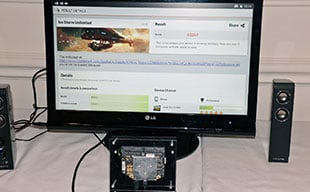Hands On With NVIDIA Tegra X1 With Benchmarks and Video
For the last few years, NVIDIA has used the lead-up to the Consumer Electronics Show to announce new Tegra-related products and technologies. This year is no different. Earlier today, we got together with representatives from NVIDIA to talk about the company’s upcoming Tegra X1 system on a chip (SoC) and see the reference platform in action, running a variety of benchmarks and demos.
At last year’s CES, NVIDIA announced the Tegra K1 featuring a Kepler-derived GPU, which has since found its way into the excellent SHIELD Tablet, Google’s Project Tango device, and the Nexus 9. The Tegra K1 proved to be a strong performer, in both its quad-core 32-bit and dual-core 64-bit configurations, and the 192-core Kepler-class GPU was a clear leader in the space. The Tegra X1, however, is a significant departure from the K1 in that it features a Maxwell-derived GPU and eight CPU cores; four ARM A57 cores and four A53s in a big.LITTLE configuration.
The Tegra X1 feature a 256-core Maxwell-derived GPU with the same programming capabilities and APU support as the powerful GM204 at the heart of the GeForce GTX 980. It also has a video engine capable of full speed 4K 60FPS video playback, along with four high-performance ARM Cortex A57 cores and four low-power Cortex A53 cores. No word on clocks yet, though. The A57 cores are 64-bit, out-of-order designs, with multi-issue pipelines, while the A53 cores are simpler, in-order, highly-efficient designs. Which cores are used will depend on the particular workload being executed by the chip—we’ve got more in-depth coverage of ARM’s big.LITTLE configurations here.
NVIDIA went with off-the-shelf CPU cores this time around to speed time to market, since the chips are also produced using TSMC’s 20nm process node. Reps from NVIDIA said they’re taking somewhat of a tick-tock strategy with Tegra, using off-the-shelf CPU cores and a new process node this time around; with the next-gen we may see custom CPU cores again.
During our hands-on time with the Tegra X1 we saw a number of demos and benchmark results that paint an interesting power and performance picture. The Maxwell-class GPU at the heart of the X1 should be quite the performer according to this initial data. In a number of benchmarks, the X1 was up to twice as fast as the K1.
In the 3DMark Ice Storm Unlimited benchmark, the Tegra X1 scored 43,267 whereas the K1 comes in around 31,456. In the Basemark X benchmark, the Tegra X1 put up a score of 44,303 and in the GFX Bench T-Rex Off-Screen test the X1 managed an impressive 124.2 FPS—for reference, the iPad Air 2 puts up 69.9 FPS in that test and the SHIELD Tablet 65.8. (There is more performance data in the video and some of the images posted here as well.)
The NVIDIA Tegra X1 also features a newly revamped video engine capable of full 4K resolution 60 frames per second video decode. To demonstrate the visual impact the higher-framerate has on the video watching experience, NVIDIA setup a couple of 4K displays, one playing a 4K 30FPS clip and another an identical 60 FPS clip. It doesn’t come across in the video we captured of the demo, but the effect on the smoothness of the video is significant.
The Tegra X1 should be a relatively high-performing part when it arrives sometime later this year, but even with all of the additional horsepower under the hood, the chip is power efficient as well. In addition to the power-saving features associated with the big.LITTLE CPU configuration and 20nm manufacturing process, Maxwell was designed to put power efficiency front-and-center as well. In another demo, NVIDIA showed some real-time power consumption data of a Tegra X1 and Apple A8X running GFX Bench. For the demo, NVIDIA isolated the power rails for the GPUs in the X1 and A8X and monitored power use while running the benchmark. The Tegra X1 was also down-clocked so that the two SoCs offered similar performance. What the demo showed was that the Tegra X1 was on average 1.7x more efficient than the A8X at similar performance levels. But keep in mind, at full clocks, the Tegra X1 can offer double the graphics performance of the A8X at similar power levels.
NVIDIA has a press conference planned as well, at which we’ll likely get more information. We’ll be covering that event as well and will post any breaking news as soon as possible.









